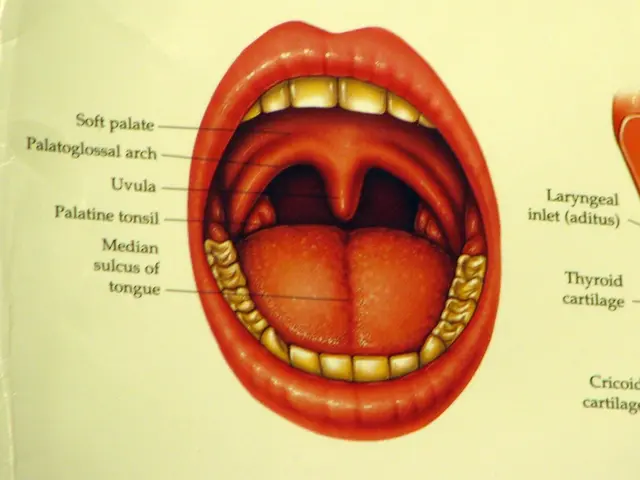Connection and Risk Factors between Breast Cancer and Ovarian Cancer
Heads up, folks! Let's dive into the relationship between breast and ovarian cancer.
Breast and ovarian cancers share some common ground, particularly due to their genetic connections. For those carrying mutations in the BRCA1 and BRCA2 genes, the risks of both types of cancer skyrocket.
Don't forget about other shared risk factors, either. Older age, being overweight or obese, never carrying a pregnancy to term, and hormone therapy after menopause can all increase the chances of either cancer.
Is there a link between breast and ovarian cancer?
According to the research, if someone has had breast cancer, they might face an increased risk of developing ovarian cancer. This is especially true when there's a link to genetic mutations like BRCA1 or BRCA2. However, it's the shared genetics that are causing this bump in risk, not the diseases themselves.
It works both ways as well - those with ovarian cancer could have an enhanced risk of subsequent breast cancer, although it varies depending on how much time has passed since the first diagnosis.
Genetic mutations are another common thread between the two cancers, especially BRCA1 and BRCA2 mutations. Around 1 in 5 families with ovarian and breast cancer have BRCA1 gene mutations, while about 20% have BRCA2 mutations.
Other risk factors for breast and ovarian cancers
A family history of either cancer, older age, being overweight or obese, having a first child after age 30, never having children, not breastfeeding, and hormone therapy after menopause are other shared risk factors for breast and ovarian cancers.
Can we reduce the risk of breast and ovarian cancer?
While some risk factors, like a personal history, cannot be changed, there are still measures that can help manage them. Regular screenings, lifestyle modifications, and, in some cases, preventive medical procedures are vital for those at higher risk.
For those with a history of breast or ovarian cancer, doctors may recommend regular mammograms, breast MRI scans, pelvic exams, transvaginal ultrasounds, and CA-125 blood tests. Genetic testing for BRCA1, BRCA2, and other relevant mutations is essential for effective monitoring and prevention.
If genetic mutations are detected, doctors may consider additional options like prophylactic surgeries, which involve removing organs or tissues to prevent cancer occurrence or spread.
Changeable risk factors
Modifiable risk factors include weight, regular exercise, alcohol consumption, and oral contraceptive use.
- Achieving and maintaining a moderate weight can help reduce the risk of both breast and ovarian cancer.
- Regular exercise may lower the chance of breast cancer, and research is supporting a positive link with ovarian cancer as well.
- Reducing alcohol intake can also lessen the risk of breast cancer.
- Oral contraceptives could slightly reduce the risk of ovarian cancer but might slightly increase the risk of breast cancer. It's essential to discuss contraception options with a doctor based on personal circumstances.
Outlook
A 2020 study suggests that individuals with both primary breast cancer and primary ovarian cancer have a relatively favorable outlook, with 5- and 10-year overall survival rates of around 90%. The survival rates are more positive when the gap between the two diseases is longer.
When to speak with a doctor
People should consult a doctor if any signs or symptoms of breast or ovarian cancer appear, especially if there's a personal or family history of these diseases. Regular monitoring for signs of recurrence or a second cancer after a previous diagnosis is essential for improved outcomes.
Cancer resources
For more evidence-based information and resources on cancer, visit our dedicated hub.
Frequently Asked Questions
- People with ovarian cancer might have an increased risk of developing bladder, bile duct, colorectal, acute leukemia, and melanoma of the eye.
- Breast cancer can spread to the ovaries, but it's relatively uncommon in early stages. It may be more likely in breast cancers that are hormone receptor-positive or in people with BRCA mutations.
- Those at high risk for ovarian cancer include people with BRCA1 or BRCA2 gene mutations, a family history of ovarian, breast, or colorectal cancer, Lynch syndrome, endometriosis, never having been pregnant, having a late first pregnancy, or being over 40 years old.
Summary
Genetic mutations are the primary link between breast and ovarian cancer, especially BRCA1 and BRCA2 mutations. People with these mutations have a significantly higher risk of developing both cancers.
Additionally, a personal or family history of one cancer increases the risk of the other, highlighting the importance of genetic testing, regular screenings, and preventive measures for those at higher risk.
People who have had breast or ovarian cancer can work with their healthcare team to monitor signs of another cancer.
- Breast and ovarian cancers share a common connection, particularly due to their genetic links, especially those involving BRCA1 and BRCA2 genes.
- If someone has had breast cancer, they might face an increased risk of developing ovarian cancer, especially when there's a link to genetic mutations like BRCA1 or BRCA2.
- Conversely, those with ovarian cancer could have an enhanced risk of subsequent breast cancer, although the risk varies depending on the time elapsed since the first diagnosis.
- A family history of either breast or ovarian cancer, older age, being overweight or obese, having a first child after age 30, never having children, not breastfeeding, and hormone therapy after menopause are other shared risk factors for both types of cancer.
- Regular screenings, lifestyle modifications, and, in some cases, preventive medical procedures can help manage the risks for those at higher risk.
- Doctors may recommend regular mammograms, breast MRI scans, pelvic exams, transvaginal ultrasounds, and CA-125 blood tests for those with a history of breast or ovarian cancer.
- Genetic testing for BRCA1, BRCA2, and other relevant mutations is essential for effective monitoring and prevention if genetic mutations are detected.
- Modifiable risk factors that can help reduce the risk of both breast and ovarian cancer include achieving and maintaining a moderate weight, regular exercise, reducing alcohol intake, and discussing contraception options with a doctor based on personal circumstances.








